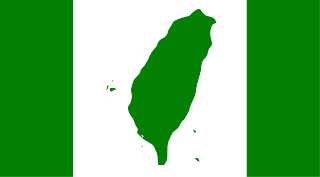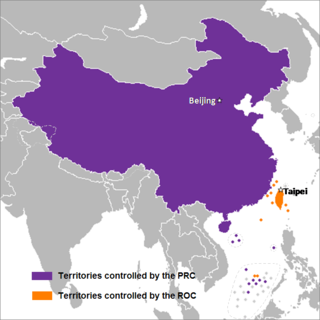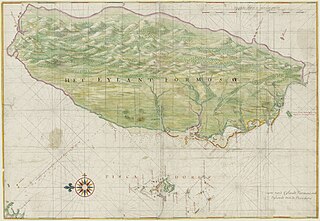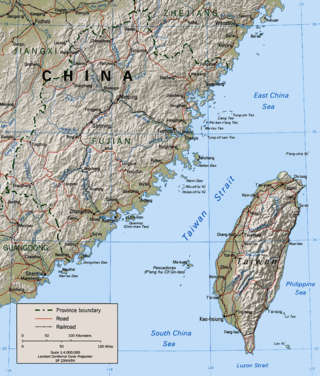
The Taiwan independence movement is a political movement which advocates the formal declaration of an independent and sovereign Taiwanese state, as opposed to Chinese unification or the status quo in Cross-Strait relations.

Chinese unification, also known as Cross-Strait unification or Chinese reunification, is the potential unification of territories currently controlled, or claimed, by the People's Republic of China and the Republic of China ("Taiwan") under one political entity, possibly the formation of a political union between the two republics. Together with full Taiwan independence, unification is one of the main proposals to address questions on the political status of Taiwan, which is a central focus of Cross-Strait relations.
The political status of Taiwan or the Taiwan issue is a long-running dispute on the political status of Taiwan, currently controlled by the Republic of China (ROC). This dispute arose in the mid-twentieth century, and is ongoing.

The Taiwan Strait is a 180-kilometer -wide strait separating the island of Taiwan and Asian continent. The strait is part of the South China Sea and connects to the East China Sea to the north. The narrowest part is 130 km wide.

As a result of the surrender and occupation of Japan at the end of World War II, the islands of Taiwan and Penghu were placed under the governance of the Republic of China (ROC), ruled by the Kuomintang (KMT), on 25 October 1945. Following the February 28 massacre in 1947, martial law was declared in 1949 by the Governor of Taiwan, Chen Cheng, and the ROC Ministry of National Defense. Following the end of the Chinese Civil War in 1949, the ROC government retreated from the mainland as the Chinese Communist Party (CCP) proclaimed the establishment of the People's Republic of China. The KMT retreated to Taiwan and declared Taipei the temporary capital of the ROC. For many years, the ROC and PRC each continued to claim in the diplomatic arena to be the sole legitimate government of "China". In 1971, the United Nations expelled the ROC and replaced it with the PRC.

The Third Taiwan Strait Crisis, also called the 1995–1996 Taiwan Strait Crisis or the 1996 Taiwan Strait Crisis, was the effect of a series of missile tests conducted by the People's Republic of China (PRC) in the waters surrounding Taiwan, including the Taiwan Strait from 21 July 1995 to 23 March 1996. The first set of missiles fired in mid-to-late 1995 were allegedly intended to send a strong signal to the Republic of China government under President Lee Teng-hui, who had been seen as "moving its foreign policy away from the One-China policy", as claimed by PRC. The second set of missiles were fired in early 1996, allegedly intending to intimidate the Taiwanese electorate in the run-up to the 1996 presidential election.

The Anti-Secession Law is a law of the People's Republic of China, passed by the 3rd Session of the 10th National People's Congress. It was ratified on March 14, 2005, and went into effect immediately. President Hu Jintao promulgated the law with Presidential Decree No. 34. Although the law, at ten articles, is relatively short, Article 8 formalized the long-standing policy of the PRC to use military means against Taiwan independence in the event peaceful means become otherwise impossible. The law does not explicitly equate "China" with the People's Republic of China.

The First Taiwan Strait Crisis was a brief armed conflict between the Communist People's Republic of China (PRC) and the Nationalist Republic of China (ROC) in Taiwan. The conflict focused on several groups of islands in the Taiwan Strait that were held by the ROC but were located only a few miles from mainland China.

The Second Taiwan Strait Crisis, also called the 1958 Taiwan Strait Crisis, was a conflict between the People's Republic of China (PRC) and the Republic of China (ROC). In this conflict, the PRC shelled the islands of Kinmen (Quemoy) and the Matsu Islands along the east coast of mainland China in an attempt to take control of Taiwan from the Chinese Nationalist Party, also known as the Kuomintang (KMT), and to probe the extent of the United States' defense of Taiwan's territory. A naval battle also took place around Dongding Island when the ROC Navy repelled an attempted amphibious landing by the PRC Navy.
The 1992 Consensus is a political term referring to the alleged outcome of a meeting in 1992 between the semiofficial representatives of the Chinese Communist Party (CCP)-led People's Republic of China (PRC) of mainland China, and the Kuomintang (KMT)-led Republic of China (ROC) of Taiwan. They are often credited as creating a diplomatic basis for semi-official cross-strait exchanges which began in the early 1990s and is a precondition set by the PRC for engaging in cross-strait dialogue.
The Dachen Islands, Tachen Islands or Tachens are a group of islands off the coast of Taizhou, Zhejiang, China, in the East China Sea. They are administered by the Jiaojiang District of Taizhou. Before the First Taiwan Strait Crisis in 1955, the islands were administered by the Republic of China (ROC).

The Formosa Resolution of 1955 was a joint resolution passed by the U.S. Senate and signed by U.S. President Dwight D. Eisenhower on January 29, 1955, to counteract the threat of an invasion of Taiwan by the People's Republic of China (PRC). The resolution gave the U.S. president the authority "to employ the Armed Forces of the United States as he deems necessary for the specific purpose of securing and protecting Formosa and the Pescadores against armed attack [by the Communists]".

Cross-Strait relations are the relations between China and Taiwan.

The Mutual Defense Treaty between the United States and the Republic of China, was a defense pact signed between the United States and the Republic of China (Taiwan) effective from 1955 to 1980. It was intended to defend the island of Taiwan from invasion by the People's Republic of China. Some of its content was carried over to the Taiwan Relations Act of 1979 after the failure of the Goldwater v. Carter lawsuit.

The following outline is provided as an overview of and topical guide to Taiwan:
Events from the year 1958 in Taiwan, Republic of China. This year is numbered Minguo 47 according to the official Republic of China calendar.
The Association for Tourism Exchange Across the Taiwan Straits is a semi-official representative office of the People's Republic of China in Taiwan handling tourism-related affairs. Its counterpart body in Mainland China by the Republic of China is the Taiwan Strait Tourism Association.

The 2022 Chinese military exercises around Taiwan were a series of military exercises by the People's Republic of China (PRC) that encircled Taiwan, officially the Republic of China (ROC). They initially lasted from 4–7 August 2022 and involved live-fire drills, air sorties, naval deployments, and ballistic missile launches by the People's Liberation Army (PLA). The exercises started in response to US Speaker of the House Nancy Pelosi's visit to Taiwan.











